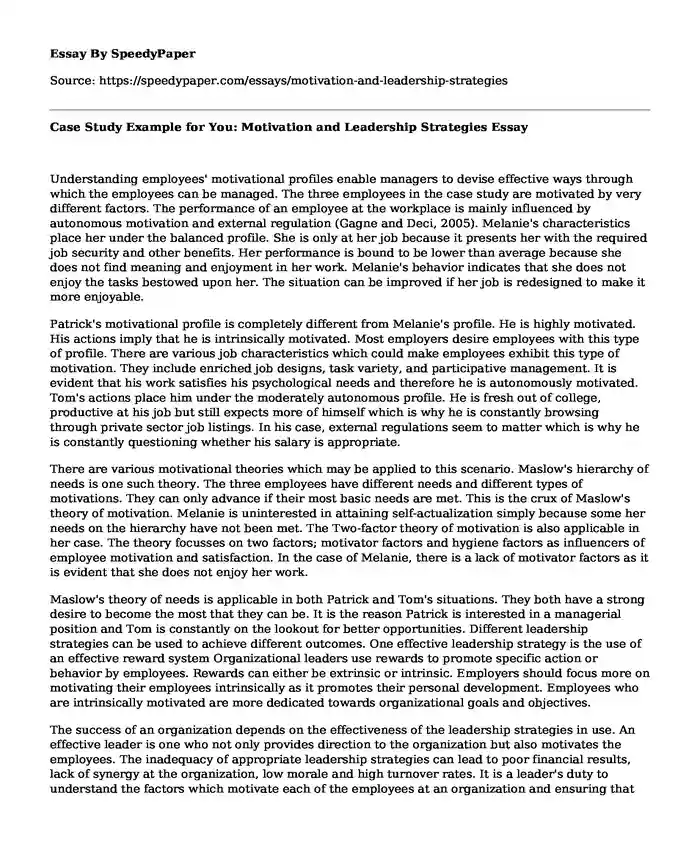
| Type of paper: | Case study |
| Categories: | Motivation Leadership style |
| Pages: | 3 |
| Wordcount: | 606 words |
Understanding employees' motivational profiles enable managers to devise effective ways through which the employees can be managed. The three employees in the case study are motivated by very different factors. The performance of an employee at the workplace is mainly influenced by autonomous motivation and external regulation (Gagne and Deci, 2005). Melanie's characteristics place her under the balanced profile. She is only at her job because it presents her with the required job security and other benefits. Her performance is bound to be lower than average because she does not find meaning and enjoyment in her work. Melanie's behavior indicates that she does not enjoy the tasks bestowed upon her. The situation can be improved if her job is redesigned to make it more enjoyable.
Patrick's motivational profile is completely different from Melanie's profile. He is highly motivated. His actions imply that he is intrinsically motivated. Most employers desire employees with this type of profile. There are various job characteristics which could make employees exhibit this type of motivation. They include enriched job designs, task variety, and participative management. It is evident that his work satisfies his psychological needs and therefore he is autonomously motivated. Tom's actions place him under the moderately autonomous profile. He is fresh out of college, productive at his job but still expects more of himself which is why he is constantly browsing through private sector job listings. In his case, external regulations seem to matter which is why he is constantly questioning whether his salary is appropriate.
There are various motivational theories which may be applied to this scenario. Maslow's hierarchy of needs is one such theory. The three employees have different needs and different types of motivations. They can only advance if their most basic needs are met. This is the crux of Maslow's theory of motivation. Melanie is uninterested in attaining self-actualization simply because some her needs on the hierarchy have not been met. The Two-factor theory of motivation is also applicable in her case. The theory focusses on two factors; motivator factors and hygiene factors as influencers of employee motivation and satisfaction. In the case of Melanie, there is a lack of motivator factors as it is evident that she does not enjoy her work.
Maslow's theory of needs is applicable in both Patrick and Tom's situations. They both have a strong desire to become the most that they can be. It is the reason Patrick is interested in a managerial position and Tom is constantly on the lookout for better opportunities. Different leadership strategies can be used to achieve different outcomes. One effective leadership strategy is the use of an effective reward system Organizational leaders use rewards to promote specific action or behavior by employees. Rewards can either be extrinsic or intrinsic. Employers should focus more on motivating their employees intrinsically as it promotes their personal development. Employees who are intrinsically motivated are more dedicated towards organizational goals and objectives.
The success of an organization depends on the effectiveness of the leadership strategies in use. An effective leader is one who not only provides direction to the organization but also motivates the employees. The inadequacy of appropriate leadership strategies can lead to poor financial results, lack of synergy at the organization, low morale and high turnover rates. It is a leader's duty to understand the factors which motivate each of the employees at an organization and ensuring that those motivating factors are provided. It is important to ensure that all the employees are committed towards an organization's goals.
References
Gagne, M., & Deci, E. L. (2005). Self-determination theory and work motivation. Journal of Organizational Behavior, 26(4), 331-362. doi:10.1002/job.322
Cite this page
Case Study Example for You: Motivation and Leadership Strategies. (2022, Jul 20). Retrieved from https://speedypaper.com/essays/motivation-and-leadership-strategies
Request Removal
If you are the original author of this essay and no longer wish to have it published on the SpeedyPaper website, please click below to request its removal:
- Art Essay Example on Mount Athos
- Essay Example: Captain Sullenberger Research
- Scholarship Essay Example
- Physics Essay Example Describing the Experiment Based on Newton's Second Law of Motion
- History and Practice of Nursing Research, Free Essay
- Research Paper Sample on Teleworking
- Essay Example on Government Privilege and Immunity
Popular categories




